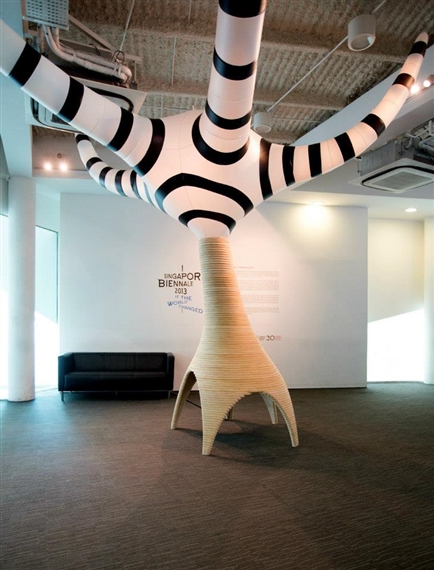This year’s Singapore Biennale 2013 takes on a socio-environmental tone, asking both artists and guests to reconsider solutions, outcomes and visions for our changing world. In its fourth year, “If the World Changed” brings together the work of 82 artists, primarily from Southeast Asia, whose work re-imagines the world we live in, and delves into the possibility of changing the way in which we see it. The work has been chosen by a roster of twenty-seven curators from across Asia, rather than a singular view by a fair director, presenting diversified viewpoints influenced by a shared cultural identity of the region. Spread across eight venues in Singapore’s Civic District, the works in the Biennale delve into contemporary themes, like cultural identity, tradition, global warming, unfair labor conditions, environmental destruction and political unrest, offering a fresh and artistic perspective on hot button issues faced by both Southeast Asia and the world.

Lim Shing Ee & Kazunori Takeishi, Mangrowe, 2013.
All pictures courtesy of Singapore Biennale 2013.
All pictures courtesy of Singapore Biennale 2013.
Opened on October 25, the fourth Biennale has drawn attention to the artists of Southeast Asia, where it will stay until February 16th. The Biennale’s focal point is centered at the Singapore Art Museum (SAM), with other participating cultural institutions including SAM at 8Q, Fort Canning Park, Waterloo Centre, the National Museum of Singapore, The Peranakan Museum, the National Library and Singapore Management University. Throughout these platforms, the vast curatorial team has created dialogues between established and emerging artists, commissioning nearly half of the 82 artworks and installations on display, and encouraging site specific projects that explore "if the world changed," with a Biennale-focused intention, and a heavy focus on video installation.
Welcoming visitors to the Singapore Biennale at the National Museum of Singapore is Eko Prawoto’s Wormhole. Rising like three volcanoes or mountains on the museum’s lawn, the structures’ natural shapes contrast from the modern architecture that has sprung up around the city. Made from natural bamboo, visitors can remove themselves from the hustle and bustle of modern life, and reconnect with nature simply by entering one of the structures. Inside, they can take in an isolate and relaxing view of the gently passing clouds through the skylight, while activating their senses with the fresh scent of the bamboo. Wormhole is an example of Prawoto’s signature works, which use architectural practices to bring humans back to nature.

Eko Prawoto, Wormhole, 2013.
Oscar Villamiel’s Payatas brings to life the intensity of the culture surrounding the landfill of the same name in Manila. Villamiel’s installation reflects the practice of the locals, including children, who scavenge the landfill for salvageable materials to be used, recycled, repaired or sold in order to make a living – literally turning one man’s trash into another man’s treasure. Using thousands of dolls excavated from the actual landfill that were once owned by hopeful children, the installation invites visitors to stroll through an eerie garden of spiked discarded doll heads, which lead to a shack containing a drawing dedicated to the lost child, alongside a prayer of hope.

Oscar Villamiel, Payatas, 2012.
Another topic explored at the Biennale touches on the more personal – the idea of identity. Shieko Reto’s Waiting Room directly addresses the waiting period that the journey of transformation is for transgender persons in both Southeast Asia and the world. The installation mimics a clinic where gender reassignment surgery is performed, with scenes depicting issues surrounding family acceptance or disapproval, confirmation into society, and legalization of official personal documents, illustrated with black and white paintings on the chairs and walls. Personal identity is further explored in the 4-channel video installation Exorcise Me by Sookoon Ang. The video installation draws out the confusion between childhood and adulthood, using teenage girls wearing thick layers of makeup masks to portray the completely self-absorbed phase that teens around the world go through. Commissioned by the Singapore Artists’ Fund, Ang’s piece hits a more person chord than global one, focusing on the transition in everyone’s life from insecure adolescent to self-confident adult.

Shieko Reto, Waiting Room, 2013.

Sookoon Ang, Exorcise Me, 2013.
The Beautiful Ghost of Capitol Theatre by Roystan Tan is a film installation that emulates Singapore’s oldest theater, aptly called Capitol. Using salvaged chairs from the theater itself as a grounding presence in the piece, the film explores the history of the building, since it’s opening in 1930. In the collaboration with Kuik Swee Boon and T.H.E. Dance Company, the film illustrates the changes from the theater’s heyday to modern times, when cultural trends have rendered it obsolete, resulting in its closing in 1998 and current redevelopment into a shopping complex. The work serves as a tribute to the disappearing cultural icons in Singapore.

Roystan Tan, Ghost of Capital Theatre, 2013.
SB: 2013 may have ominous undertones, but it uses the power of art to dissect, communicate and understand how we, as humans, must deal with the effects of our own socio-economic shortcomings. From issues like pollution that affect the world as a whole to more personal, localized traumas, like coming-of-age, the artists in the Biennale communicate messages of admittance and hope, pushing viewers to get inspired by the installations to make positive changes in their own worlds.